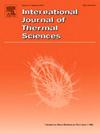Curvature-property coupling governed heat transfer deterioration in supercritical helically coiled tubes: Mechanistic insights and mitigation strategies via structural parametrization
IF 5
2区 工程技术
Q1 ENGINEERING, MECHANICAL
International Journal of Thermal Sciences
Pub Date : 2025-05-22
DOI:10.1016/j.ijthermalsci.2025.110003
引用次数: 0
Abstract
The unique thermo-hydrodynamic coupling phenomena in the helically coiled tube (HCT) handling supercritical fluids present both opportunities and challenges for next-generation compact heat exchangers. While the pronounced thermophysical property variations near pseudo-critical temperatures (Tpc) and curvature-induced secondary flows synergistically enhance heat transfer coefficient (HTC), their nonlinear coupling mechanisms may unexpectedly provoke severe heat transfer deterioration (HTD). Through systematic numerical investigations, this study reveals that circumferential wall temperature inhomogeneity (CWTI) exhibits an inverted N-shaped evolution, providing valuable insights for thermal homogenization design near Tpc. The secondary flow Reynolds number (Se), quantifying secondary flow intensity, shows a monotonic increase with decreasing coil diameter (Dc) or inner diameter (Di), reaching saturation in high-enthalpy regions. Notably, CWTI demonstrates non-monotonic behavior, achieving minimum values near Tpc before manifesting distinct rebound characteristics near Tpc conditions. Parametric analysis establishes that: (1) Elevating heat flux (q) increases Se, reducing Dc boosts it by 50.3 %, and decreasing Di raises it by 60.0 %. (2) HTD predominantly initiates at the outer wall under high-q conditions, with Dc reduction achieving HTD suppression and 26.9 % enhancement in the local HTC; (3) Reducing the Di results in a reduction of maximum CWTI by 22.5 %–28.6 %, suggesting that structural parametrization effectively mitigates wall temperature non-uniformity, thus suppressing the HTD. While centered on supercritical water, the dimensionless scaling relationships demonstrate extendibility to other media, with the curvature-property coupling mechanism both elucidating fundamental interactions and guiding robust heat exchanger design.
曲率-性质耦合控制超临界螺旋盘管传热恶化:通过结构参数化的机理见解和缓解策略
螺旋盘管(HCT)处理超临界流体时独特的热流耦合现象为下一代紧凑型换热器带来了机遇和挑战。虽然在拟临界温度(Tpc)附近明显的热物性变化和曲率诱导的二次流协同提高了换热系数(HTC),但它们的非线性耦合机制可能会意外地引起严重的换热恶化(HTD)。通过系统的数值研究,本研究揭示了周向壁面温度不均匀性(CWTI)呈现倒n型演化,为Tpc附近的热均匀化设计提供了有价值的见解。二次流雷诺数(Se)随着线圈直径(Dc)或内径(Di)的减小而单调增加,在高焓区达到饱和。值得注意的是,CWTI表现出非单调性,在Tpc条件下达到最小值,然后在Tpc条件下表现出明显的反弹特征。参数分析表明:(1)提高热通量q使Se增大,降低Dc使Se增大50.3%,降低Di使Se增大60.0%。(2)在高q条件下,HTD以外壁起始为主,Dc降低可抑制HTD,局部HTC增强26.9%;(3)降低Di可使最大CWTI降低22.5% ~ 28.6%,表明结构参数化有效地缓解了壁温不均匀性,从而抑制了HTD。虽然以超临界水为中心,但无因次标度关系证明了其他介质的可扩展性,曲率-性质耦合机制既阐明了基本的相互作用,又指导了稳健的换热器设计。
本文章由计算机程序翻译,如有差异,请以英文原文为准。
求助全文
约1分钟内获得全文
求助全文
来源期刊

International Journal of Thermal Sciences
工程技术-工程:机械
CiteScore
8.10
自引率
11.10%
发文量
531
审稿时长
55 days
期刊介绍:
The International Journal of Thermal Sciences is a journal devoted to the publication of fundamental studies on the physics of transfer processes in general, with an emphasis on thermal aspects and also applied research on various processes, energy systems and the environment. Articles are published in English and French, and are subject to peer review.
The fundamental subjects considered within the scope of the journal are:
* Heat and relevant mass transfer at all scales (nano, micro and macro) and in all types of material (heterogeneous, composites, biological,...) and fluid flow
* Forced, natural or mixed convection in reactive or non-reactive media
* Single or multi–phase fluid flow with or without phase change
* Near–and far–field radiative heat transfer
* Combined modes of heat transfer in complex systems (for example, plasmas, biological, geological,...)
* Multiscale modelling
The applied research topics include:
* Heat exchangers, heat pipes, cooling processes
* Transport phenomena taking place in industrial processes (chemical, food and agricultural, metallurgical, space and aeronautical, automobile industries)
* Nano–and micro–technology for energy, space, biosystems and devices
* Heat transport analysis in advanced systems
* Impact of energy–related processes on environment, and emerging energy systems
The study of thermophysical properties of materials and fluids, thermal measurement techniques, inverse methods, and the developments of experimental methods are within the scope of the International Journal of Thermal Sciences which also covers the modelling, and numerical methods applied to thermal transfer.
 求助内容:
求助内容: 应助结果提醒方式:
应助结果提醒方式:


